
A churchyard is the land surrounding the church and is used as a graveyard. It has been consecrated (set apart as sacred) by a bishop and is sometimes called 'God's Acre'. The area of St James's churchyard, including the church building, is estimated to be about 1.6 acres. It is an area of great beauty in many ways and used regularly by local people, especially children and parents walking to and from school. Footpaths run through the churchyard, but there are no public rights of way. There is a double garage beside the hall which is used mainly for storage for the church and for the nursery school, who are regular weekday hall users. There is also a shed in the churchyard for the storage of garden equipment. The remainder of the churchyard is a burial ground. See the Churchyard Plan for details.
A Churchyard Management Plan was drafted in 2021 with the vision “managing and maintaining the churchyard as a haven for people and biodiversity”.
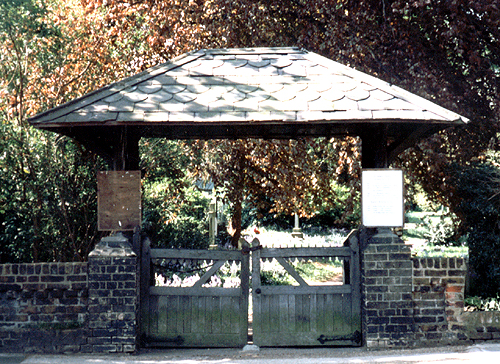 The Lych
The Lych
St James's lych consists of a roofed porch-like structure over a gate, built of wood with four upright wooden posts in a rectangular shape. On top of this are a number of beams holding a pitched roof covered with clay tiles. The lych is really part of the church, lyc being the old English word for corpse or body. Thus the words 'lych gate' really means 'corpse gate'. Find out about the 2006 Lych Gate Renovation.
Graves
There are over 4,000 people buried in the churchyard in over 1,000 graves. The first burial was that of Walter Richard Daines, aged 11 months in l864 and the very last burial was Bruna (Walter) Blaschke in 1987. Many fascinating people are buried in the churchyard: Canadian Joe Boyle, whose remains were exhumed and returned to Canada in 1983, 60 years after his death; three station masters from Fulwell Station; John Templeton, the opera singer; and many more. Find out about the Graves in the churchyard.
Only burials in existing spaces and the interment of ashes now take place. Ashes are interred in the Garden of Rest (sometimes called Garden of Remembrance), an area of grass near the lychgate, and occasionally in graves. On request, names are recorded in a Book of Remembrance inside the church. A new rose garden has been started on the south-east side of the interment lawn and is proving popular and successful. Dedicated roses are planted with a small memorial plaque and instructions for same are kept in the church office.
In 1991 the churchyard was closed by an Order in Council made by the Privy Council and handed over to the London Borough of Richmond upon Thames to maintain.
In 2018 the church was approached by Roland Bostock from the West Middlesex Family History Society, which was aiming to record the details of every grave in the former county boundary. As well as the inscriptions, St James’s was the first church to have photos of all the gravestones attached to the online records. Roland, and his assistant, Yvonne, took photos of every grave as well as recording all the inscriptions. See the documents Memorials & Graves Introduction and Memorials & Graves both by Roland Bostock.
The Commonwealth War Graves Commission (CWGC) has established an initiative to provide care for the ‘Scattered War Graves’ throughout the UK. There are fourteen Scattered War Graves in St James Churchyard and twelve Canadian War Graves. In addition, four graves within private memorials have also been identified. A CWGC sign, notifying that the churchyard contains war graves has been affixed to the iron railings at the south porch entranceway to the church.
Churchyard Records
The original churchyard records were on a huge roll of linen inscribed with each individual grave with a name in each box. In the early 1990s, after clearing the undergrowth, a working party set about recording the names and positions of all the graves in the churchyard. Plans were drawn and a numbering scheme was used to make it easier to locate the graves. All this information was collated into a booklet 'Churchyard Records 1864-2000' which was published in February 2001. Some years later it was updated and a list of interments of ashes from 2000-2014 was included. The booklet not only listed all the graves, but included plans of each area of the churchyard with the numbers of the graves.
An online searchable database for the Churchyard Records was developed in 2007 - Churchyard Records - search by surname or year. Together with the booklet this has proved to be a very useful reference with the increasing interest in genealogy and searches of past relatives from people researching their family history.
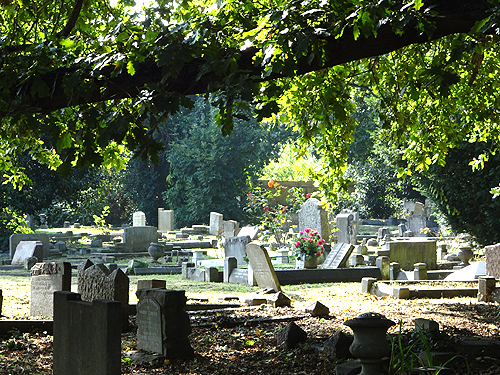 |
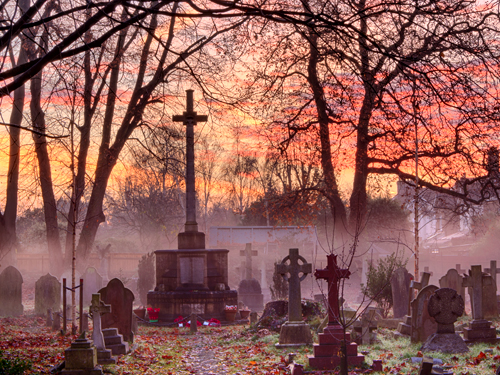 |
 |
Garden Development
A churchyard management scheme was set up in 2017 and created a wildlife meadow area which lies on the east side of the churchyard between the War Memorial and the large oak tree. Further developments along these lines may be developed over time with a view to the churchyard receiving classification as a ‘designated local wildlife area’. To help with the creation and future maintenance of these wildlife areas the St James’s Gardening Club, (open to all), was launched.
There were various Diocese of London’s conservation initiatives around this time, some under the banner of 'Caring for God’s Acre', a charity which promotes and assists in the care of churchyard green spaces. St James Church took part in these and made various steps to become pro-active in the management of the churchyard by working together with the London Borough of Richmond and Wandsworth Council to manage, protect and develop its wildlife flora and fauna.
When toilets were installed in church it was necessary to excavate the ground near the west porch for pipework. This was a good opportunity to replant the area with attractive shrubs and these are now growing well. Also sadly, in 2017, it was necessary to have the lovely copper beech tree at the corner of St James’s Road and Park Road removed as it was diseased. In its place is a young tree and in 2019 the Gardening Team worked hard to create a small garden with flowerbeds, lawn and a bench. Donated flowering plants and small shrubs were added. The mixed shrub pack given via the Mayor of London’s 'Greening Initiative' was planted as a mixed hedge along the iron railings and has taken well. The garden is a sun trap that has already attracted visitors and wildlife alike.
 |
| Congratulations to the Eco Church Team on our Silver Award. The picture shows the award being presented by Helen Stephens from A Rocha. |
A Churchyard Management Plan was drafted in 2021 with the vision “managing and maintaining the churchyard as a haven for people and biodiversity”.
Site of Interest for Nature Conservation
St James's churchyard is an open space and freely accessible. The London Borough of Richmond recognises it as a Site of Interest for Nature Conservation (SINC). It is managed by St James's Church, in collaboration with the borough, for biodiversity. Have a look at the results of the churchyard survey made in 2002.
Wildlife Flora and Fauna
Some of the trees, shrubs and flowers growing in the churchyard have long been thought to have a symbolic meaning. They remind us of things connected with the Christian faith. The yew trees are slow-growing and very long-lived trees, so they have been looked upon as a symbol of immortality and therefore a suitable tree to be planted in the place where people are buried. The prickly leaves of the holly tree have often been thought of as a reminder of the crown of thorns which Jesus wore when he was crucified. The red berries are like drops of blood, and serve to remind us that Christ's blood was shed for us. Thus the holly tree has come to be known as a reminder of the Passion of Christ. Graveyards usually have yew trees and holly in them. Yew trees and holly are 'evergreens' - the leaves do not die in winter. These plants remind us that we can live for ever in heaven.
The daffodil and the lily remind us of everlasting life. Though the bulbs look dead when they are placed in the ground, new life springs within them and they blossom into beautiful flowers. So our church is decorated with such blooms especially at Easter time. The lily of the valley, with its white blossoms is a symbol of purity and humility, and it is often associated with Mary the mother of Jesus. The clover, being a three-leaved plant is an obvious symbol of the Holy Trinity. Each leaf has three parts, which are not three separate leaves, but one leaf. So likewise, God is God the Father, God the Son, and God the Holy Ghost; yet He is not three Gods, but one. The Christmas rose has been thought of as a reminder of the Nativity.
Find out more
Plan of the Churchyard (document)
Churchyard Management Plan (document)
St James’s Gardening Club (photo album)
Spring in the Churchyard (photo album)
2006 Lych Gate Renovation (document)
Graves in the Churchyard (document)
‘Scattered War Graves’ (document)
Churchyard Records
Churchyard Survey 2002 (external website)
The History of the Churchyard
Annual Parochial Church Meeting Reports (these documents contain the annual reports of the various church teams or groups associated with St James's Church. Scroll down the document of the year you are interested in to find the report you want)
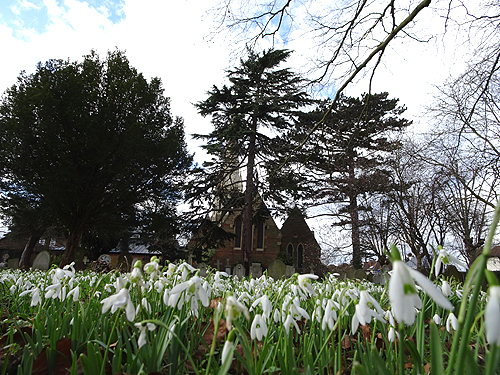 |
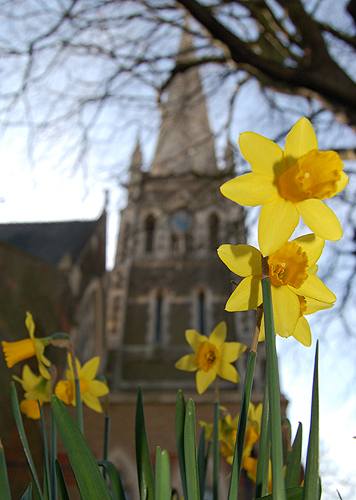 |
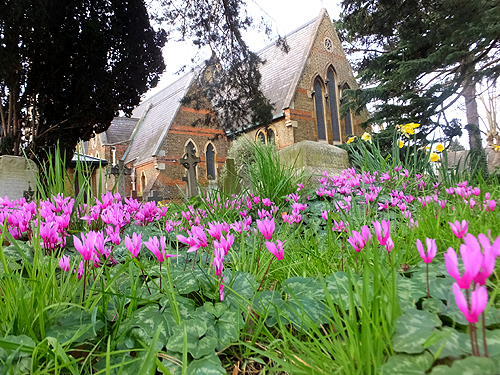 |